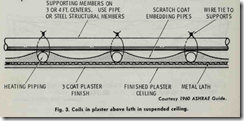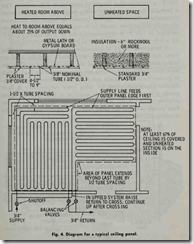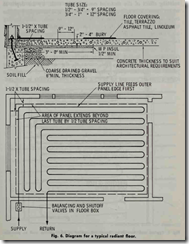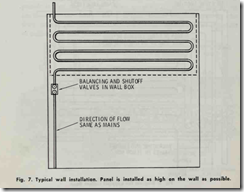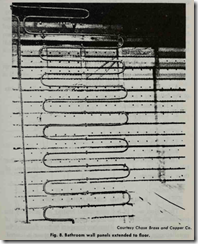It is very important that the design of a radiant panel heating system be correct at the outset. The fact that the coils or cables are permanently embedded in concrete, plaster or some other type of material makes corrections or adjustments very difficult and expensive.
Many manufacturers that produce radiant panel heating equipment have devised simplified and dependable methods for designing this type of heating system. In most cases, the manufacturer will send you a catalog and any other available materials to assist you in calculating the requirements of your particular installation. Addresses of manufacturers can be obtained from your local library
PANEL TEMPERATURES
When planning a radiant panel heating system, you must take into consideration the maximum allowable temperatures of the heating panels. These temperatures will vary according to the location of the panel.
The maximum allowable temperature of a ceiling panel depends upon its height. A maximum allowable temperature of 100°F. is recommended for panels installed in 7 ft. ceilings. This is probably the most common ceiling height used in modern home construction. For each one foot increase in height, the maximum allowable temperature should be increased by 10°F. Thus, a temperature of 110°F. is recommended for an 8 ft. ceiling; 120°F. for a 9 ft. ceiling; and 130°F. for a 10 ft. ceiling.
A temperature of 85 °F. is recommended for floor panels. This lower maximum allowable temperature results from the more effective insulating characteristics of the materials used to cover the floor coils. Lower temperatures are recommended for floor panels to protect furniture, carpets and floor finishes from heat damage. Another important reason for using lower temperatures in floor panels is that the feet are more sensitive to heat than the upper portions of the body. As a result, lower temperatures in the floor panels produce the same results as slightly higher ones do in ceiling and wall panels.
The maximum allowable temperature for wall panels should be about 100 to 110°F. The temperature will depend upon how the wall panel is used. A lower temperature is recommended if the panel is used to supplement the heat from a ceiling or floor radiant heating panel. A higher maximum allowable temperature is necessary if the wall panel is the only source of heat.
The maximum allowable temperatures given in the preceding paragraphs are only recommended temperatures. The specific maximum allowable temperatures used in an installation will depend upon a number of variables such as the type of material covering the coils, ducts or heating cables; the location of the panel (ceiling, floor or wall); the amount of heat loss, etc.
It must be remembered that the maximum allowable temperature is the temperature of the heat radiated from the panel. The temperature of the water in the coils will be slightly higher. The temperature of the water is reduced to some degree by the insulating effect of the material covering the coils, by the depth at which the coils are buried, and by the temperature drop in the coils caused by normal heat loss. For these reasons, it is customary to speak in terms of the average temperature of the water circulating in the coils. In many installations, the average water temperature will vary between 120°F. and 130°F.
An important factor to consider when designing a hot water radiant panel heating system is the temperature drop (i.e. the temperature difference) that occurs in the coils of the heating panel. As the hot water passes through the coils of a panel, it loses a certain amount of heat; a factor which results in the outlet water having a lower temperature than the inlet water. This temperature difference ranges between 20°F. and 30°F.
The degree of temperature drop in hot water radiant heating panels must be limited or the efficiency of the heating system will suffer. On the other hand, maintaining the maximum allowable temperature of the panel is also essential to the efficiency of the heating system. The temperature drop and the maximum allowable temperature must be adjusted so that each will operate within the desired temperature range.
